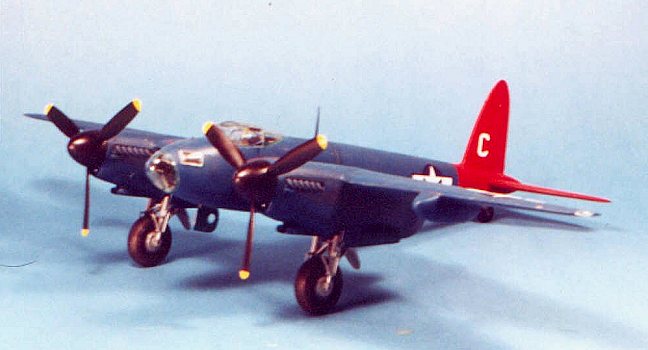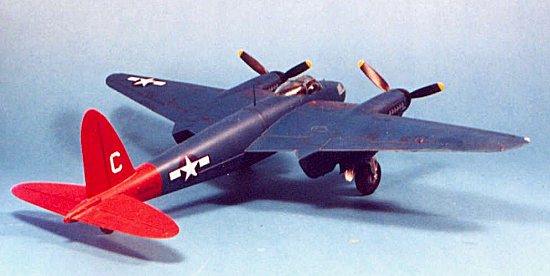
|
KIT: |
Tamiya 1/48 Mosquito PR.XVI |
|
KIT # |
61066 |
|
PRICE: |
$38.00 |
|
DECALS: |
See Review |
|
REVIEW & |
|
|
NOTES: |
Conversion using Paragon set |
RED-TAILED SNOOPER

|
HISTORY |
The deHavilland Mosquito really was a "jack of all trades." Originally designed as a bomber that depended on speed for defense, it served as the primary British long-range photo-reconaissance aircraft, the primary British long range tactical bomber and strike aircraft, and the primary British night fighter; in all cases it proveded exemplary service.
The first Mosquitoes to see operational service were the B.Mk.IV series 1s utilized by the Photographic Development Unit. The first mission flown by the Mosquito was a high altitude reconnaissance flight over the U-boat bases at Bordeaux, Brest and La Pallice on September 19, 1941; ot was chased by three Bf-109s, which it easily outpaced at 23,000 feet. So reliable was the photo-recon Mosquito that with only ten aircraft, the P.D.U. was able to mount as many as ten sorties a day.
Each major development of the Mosquito bomber was paralleled by a photo reconnaissance version, with cameras in the bomb bay and additional fuel. The P.R.XVI was the photo-recon development of the B.Mk.XVI, the first operational pressurized Mosquito. Equipped with Merlin 70 series engines, the Mk.XVI was capable of 422 m.p.h., at 30,000 feet with a range of 2,050 miles, which allowed the airplane to operate at will over all of Europe. Though the Luftwaffe set up several special fighter units to combat the Mosquito, it was not until the summer of 1944 that Mosquito losses became anything for the RAF to be concerned over, with the operational debut of the Messerschmitt Me-262 jet fighter. Even then, the Mossie "blue birds" continued to operate over Europe by day at a far lower loss rate than any other Allied aircraft.
The Red-Tailed Snooper:
The USAAF went to war woefully unequipped to meet its needs for photo reconnaissance with aircraft that had any chance of making it back to base with their pictures. Only the photo recon version of the P-38 "Lightning" was of any value. The proven Mosquito was tempting. At first it was planned to manufacture the P.R.IV in the United States as the F-8; by the time this came about, however, the Mk.IV was nearly obsolescent and none of the F-8s ever saw operational service.
 In the ETO, the 13th Photo Recon Squadron began service with the F-4 and F-5
"Lightning" in February 1943. In all its versions, the
"Lightning" had trouble in the E.T.O. operating above 25,000 feet. It
is now thought this was due to the use of lower-quality British avgas in
England, since the airplane had no trouble in the Mediterranean or the Pacific,
where American avgas was available. The F-5 was prone to engine failure
operating out of England, and the loss of an engine over the Continent made the
unarmed airplane an easy target for German fighters. The answer was the
Spitfire, and the first P.R.XI aircraft arrived at the 14th PRS in September
1943.
In the ETO, the 13th Photo Recon Squadron began service with the F-4 and F-5
"Lightning" in February 1943. In all its versions, the
"Lightning" had trouble in the E.T.O. operating above 25,000 feet. It
is now thought this was due to the use of lower-quality British avgas in
England, since the airplane had no trouble in the Mediterranean or the Pacific,
where American avgas was available. The F-5 was prone to engine failure
operating out of England, and the loss of an engine over the Continent made the
unarmed airplane an easy target for German fighters. The answer was the
Spitfire, and the first P.R.XI aircraft arrived at the 14th PRS in September
1943.
The most persistent enemy of USAAF operations in the ETO was the atrocious European weather. It was possible for bases to be fogged in in England while the skies were CAVU over Germany, and vice-versa. Weather forecasting was still more an art than a science, and actual observation of weather conditions was still the most reliable information. The 18th Weather Squadron began operations in October 1943, flying B-24s; these were not really suited to individual sorties over Germany, no matter how vital the information. By April 1944,, the 802nd Reconnaissance Group was formed and the 653rd PRS was equipped with British P.R.XVI Mosquitoes for weather reconnaissance over Germany. That summer the 802nd became the 25th Bomb Group (Photo).
The overall blue Mosquitoes were often mistaken for Luftwaffe Ju-88s by Eighth Air Force fighter escort units that found them flying alone over Germany; fortunately none were lost to "friendly fire," though there were some close escapes. In August 1944, the problem led to the aircraft being given a bright red tail for identification purposes.
The effectiveness of the Mosquito weather recon aircraft is seen in the increasing sortie rate by the Eighth Air Force after April 1944, which was as much a result of better information regarding weather over the targets as it was the increase in units assigned to the Eighth.
|
THE KIT |
The B.Mk.IV Mosquito was the second kit of the Mossie released by Tamiya, a year after the release of the fighter-bomber version. The kit can be made up as either a B.Mk.IV or a P.R. Mk.IV, with the provision of cameras for the three positions they were carried in the airplane.
I had on hand the Paragon resin conversion set for the high altitude Merlin cowlings, which is actually made to fit the Airfix kit. However, the Airfix and Tamiya Mosquitoes both apparently came from accurate drawings, because they are almost interchangeable, major part for major part. I decided to use the Paragon set on a Tamiya Mossie to create a P.R.XVI.
|
CONSTRUCTION |
Construction of the kit proceeded as it does for all other Tamiya Mosquitoes, other than the conversion, and the modeler who wants to know how to build the kit is referred to the other reviews of the model here at Modeling Madness.
Using The Paragon Conversion:
 I cut off the forward engine cowlings from the kit, and made the discovery
that the Paragon parts are just a hair too small for the Tamiya kit when I tried
to fit them in position. I glued them in and puttied over the join area for
about half an inch onto the resin cowling. When dry, I sanded the area smooth;
this required some extra puttying to get it really smooth, followed by several
coats of Mr. Surfacer 500 before I was fully satisfied. I then rescribed the
detail that had been sanded off and then attached the engine nacelles to the
wings.
I cut off the forward engine cowlings from the kit, and made the discovery
that the Paragon parts are just a hair too small for the Tamiya kit when I tried
to fit them in position. I glued them in and puttied over the join area for
about half an inch onto the resin cowling. When dry, I sanded the area smooth;
this required some extra puttying to get it really smooth, followed by several
coats of Mr. Surfacer 500 before I was fully satisfied. I then rescribed the
detail that had been sanded off and then attached the engine nacelles to the
wings.
One problem, so far as I was concerned, was that the exhausts of the Paragon conversion set do not look like the exhausts on any high-altitude Mosquito I have photographs of. I did not have any way of making correct exhausts, and so decided I would leave well enough alone in the expectation that most people who saw the completed kit wouldn't realize they were looking at incorrect exhausts. (So far, no one has noticed, or at least no one has commented on it.)
Also, since the cowlings are slightly undersized, it will be necessary to sand down the prop spinners so they fit - you will take off plastic right to the last bit, and it will work. In truth, the spinner will not be "correctly shaped," but again it is something most will not notice.
With the airplane assembled, it was time for painting.
|
PAINT & DECALS |
Painting:
After pre-shading the model, I painted the tail surfaces with Gunze-Sanyo "Red Madder," a scarlet Red. Once these were dry, I masked off and shot the rest of the model with my own mixture of "P.R.U. Blue," made up from Tamiya Blue, Intermediate Blue, and Sky (to give it the greenish tinge one finds in this shade). I shot this and when it was dry I futured the model to prepare for decals.
Decals:
 There is no decal sheet available for the American P.R.XVI; the only decal
sheet I am aware of that does any P.R.XVI is an Aeromaster sheet that does a
P.R.XVI based in Italy with a rudder and vertical fin in red and white diagonal
stripes. I used U.S. National insignias from an old SuperScale sheet in the
decal dungeon, and a white "C" from another old SuperScale sheet. The stenciling
came from the kit decals.
There is no decal sheet available for the American P.R.XVI; the only decal
sheet I am aware of that does any P.R.XVI is an Aeromaster sheet that does a
P.R.XVI based in Italy with a rudder and vertical fin in red and white diagonal
stripes. I used U.S. National insignias from an old SuperScale sheet in the
decal dungeon, and a white "C" from another old SuperScale sheet. The stenciling
came from the kit decals.
Final Finish:
Once the model was dry, I hit it with several coats of "Flat Future" to get an almost-flat finish, then installed the landing gear, and nose and canopy glass. The props were also added. I used Tamiya "Smoke" to simulate the oil stains on the fuselage, and mixed Smoke with a bit of Gunze RLM66 Grey to use for the exhaust stains.
|
CONCLUSIONS |
The nearly mono-chromatic finish of this model allows the viewer to concentrate on the shape of the Mosquito. To my mind, the unarmed bomber and photo recon versions were the most esthetically pleasing versions of this beautiful airplane. I hear that Paragon is going to make a conversion set for the high altitude Mosquitos that is for the Tamiya kit. Personally, if I hadn't already had the set I did, I would have waited myself, and I suggest you do so, too. Hey, Neil!! Let's speed it up over there, eh??
Review kits courtesy of my wallet.
If you would like your product reviewed fairly and quickly by a site that has over 1,500 visits a day, please contact me or see other details in the Note to Contributors.